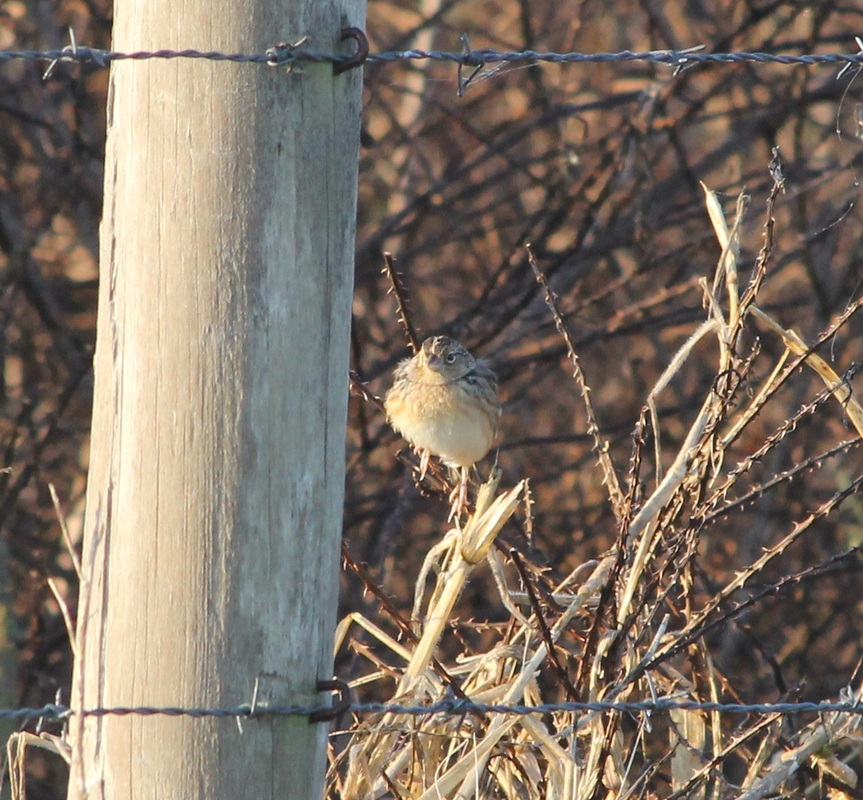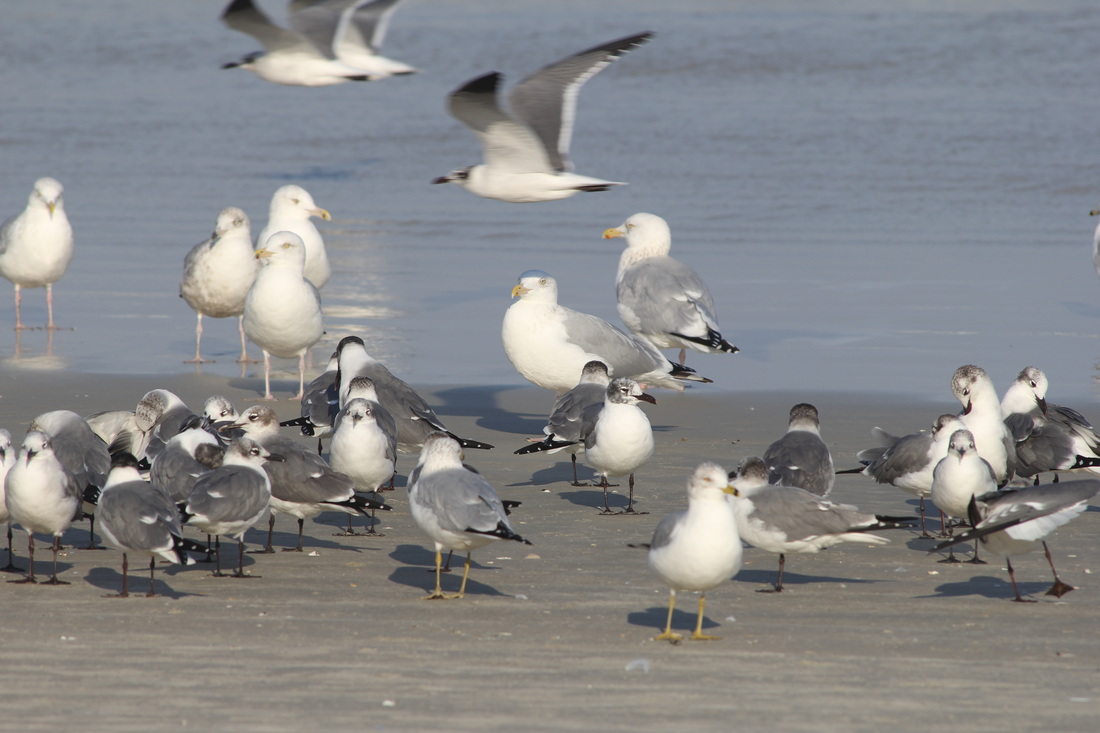Another early start today, as I went on the morning trip to Charles H. Bronson State Forest. This time, instead of meeting at festival HQ to pile onto a bus or carpool, we were in charge of getting ourselves there. So I slept a little later (til 5:30), and then charged off into the pre-dawn fog in my rented Ford Fusion.
It was a winding route through a very rural area, and the fog got really thick at times, so it would’ve been easy to get lost. In fact, when I arrived, many of the retirees were complaining loudly about just that. But I made it on time, and met our expert guides for the day, Mitchell Harris from the Florida Ornithological Society and John Puschock (who was also a guide on my trip to Marl Bed Flats yesterday). These two guys are among the sharpest birding guides I’ve encountered. Over and over they would identify a bird based on a single call note or a super-distant glimpse, and get everyone in the group to see it. We also had two escorts from the Florida Forest Service, Paul Hartsfield and Steve Stipkovits, who graciously drove us beyond the “no vehicles allowed” signs and shared a lot of intimate knowledge about the management of the land out there, a big tract of ranchland on the west side of the Saint Johns River. Very cool.
It was a winding route through a very rural area, and the fog got really thick at times, so it would’ve been easy to get lost. In fact, when I arrived, many of the retirees were complaining loudly about just that. But I made it on time, and met our expert guides for the day, Mitchell Harris from the Florida Ornithological Society and John Puschock (who was also a guide on my trip to Marl Bed Flats yesterday). These two guys are among the sharpest birding guides I’ve encountered. Over and over they would identify a bird based on a single call note or a super-distant glimpse, and get everyone in the group to see it. We also had two escorts from the Florida Forest Service, Paul Hartsfield and Steve Stipkovits, who graciously drove us beyond the “no vehicles allowed” signs and shared a lot of intimate knowledge about the management of the land out there, a big tract of ranchland on the west side of the Saint Johns River. Very cool.
The place was vast and birdy, and this was the first field trip of the festival that I kinda wished could last longer – it seemed like we were still turning up new and interesting birds at the end. But I do not have any complaints. What I do have, I’m happy to report, is that rare and precious prize: a lifer. (That is, a new species to put on my life list.) And I also have a measure of redemption, since the lifer I got was a close relative of the stubborn LeConte’s Sparrow that I missed yesterday. Today’s gem was a Grasshopper Sparrow.
This time, there was no drama to it. It was early in the trip, and the group was sort of spread out, looking in several different directions, when I heard Mitchell say he had a Grasshopper Sparrow in his scope. He didn’t even sound that excited, because when it comes to Ammodramus – the genus of notoriously shy sparrows to which both LeConte’s and Grasshopper belong – Grasshopper is among the more widespread and less shy. In fact, I’ve been a little embarrassed for some time that I’d never seen one, as a birder of my experience level. Only a little embarrassed, because they’re not easy to come by. But it was still sort of developing into a nemesis bird for me.
Well, no more. This little sucker sat there on the wire for minutes on end. It was a cool morning, and the bird seemed to be almost dozing, just soaking up the sun. Everyone in the group had long, leisurely looks, and I had time to grab the photos above – though I didn’t dare venture close enough to get really good ones, and risk being The Guy Who Scared Off the Grasshopper Sparrow. Anyway, it was awesome. ABA-area life bird #515!
Like I said, the whole place was pretty nice, and I grabbed a few pics of the more charismatic species that we saw. Every big open field seemed to have at least a few of these guys….
Well, no more. This little sucker sat there on the wire for minutes on end. It was a cool morning, and the bird seemed to be almost dozing, just soaking up the sun. Everyone in the group had long, leisurely looks, and I had time to grab the photos above – though I didn’t dare venture close enough to get really good ones, and risk being The Guy Who Scared Off the Grasshopper Sparrow. Anyway, it was awesome. ABA-area life bird #515!
Like I said, the whole place was pretty nice, and I grabbed a few pics of the more charismatic species that we saw. Every big open field seemed to have at least a few of these guys….
Eventually we tore ourselves away from there and went our separate ways. I grabbed a quick bite, made a few notes about the morning, called my wife, and headed back out. I had a doubleheader today, and the afternoon field trip was to Daytona Beach Shores, site of the largest known congregation of gulls on any beach in the United States. In a word, it was dope.
When I got there, there was a line of birders with spotting scopes pointed out at the sea, and a couple guys were shouting an intense play-by-play of what was happening out there. They were our two guides, Michael Brothers, director of the Marine Science Center in Ponce Inlet, and Cameron Cox of Leica. They stood a few feet apart, each with his eye buried in his scope, and the area around them was filled with excited but bewildered birders. One of the guides would be all, “Jaeger! Twelve o’clock, just below the horizon, moving left, chasing a Laughing Gull!” while the other one was all like “Jaeger! down low, moving right – there he goes up! Now back to the left, chasing a Ring-billed Gull!” It was fucking exciting. But also I didn’t have a scope, just my puny binoculars, and for a few minutes I was kinda worried I wasn’t actually going to see much.
But then I did pick up on one of those Jaegers, and I got a pretty good look. Later I would get even better looks, as we saw more of them harassing the gulls out over the water, trying to steal their dinners. These were Parasitic Jaegers, extremely gifted flyers who usually stay too far out at sea to be seen from the shore – oh and by the way, my life bird #516! Ha, two lifers in one day! RIDIC.
Well, from then on the rest was gravy. The main reason we were at this particular spot was the gulls, which blanketed the beach in both directions.
When I got there, there was a line of birders with spotting scopes pointed out at the sea, and a couple guys were shouting an intense play-by-play of what was happening out there. They were our two guides, Michael Brothers, director of the Marine Science Center in Ponce Inlet, and Cameron Cox of Leica. They stood a few feet apart, each with his eye buried in his scope, and the area around them was filled with excited but bewildered birders. One of the guides would be all, “Jaeger! Twelve o’clock, just below the horizon, moving left, chasing a Laughing Gull!” while the other one was all like “Jaeger! down low, moving right – there he goes up! Now back to the left, chasing a Ring-billed Gull!” It was fucking exciting. But also I didn’t have a scope, just my puny binoculars, and for a few minutes I was kinda worried I wasn’t actually going to see much.
But then I did pick up on one of those Jaegers, and I got a pretty good look. Later I would get even better looks, as we saw more of them harassing the gulls out over the water, trying to steal their dinners. These were Parasitic Jaegers, extremely gifted flyers who usually stay too far out at sea to be seen from the shore – oh and by the way, my life bird #516! Ha, two lifers in one day! RIDIC.
Well, from then on the rest was gravy. The main reason we were at this particular spot was the gulls, which blanketed the beach in both directions.
They let us walk practically right up to them for close study. It was a more deliberate, analytical style of birding than any of my other trips here, which was great in its own way. And Michael and Cameron are freakin geniuses. I learned more about ID’ing gulls in a couple hours with them than I have in years of staring at birds and books on my own.
Oh and by the way, all this was happening on a gorgeous beach as the sun slowly set behind us.
It was a lovely, satisfying end to a great Day Three. Now, Day Four (the last day at the festival for Birding For Humans) begins with a bus ride leaving from festival HQ at 5am sharp. So… I’m gonna have to peace out now. May your dreams be filled with lifers!













 RSS Feed
RSS Feed

